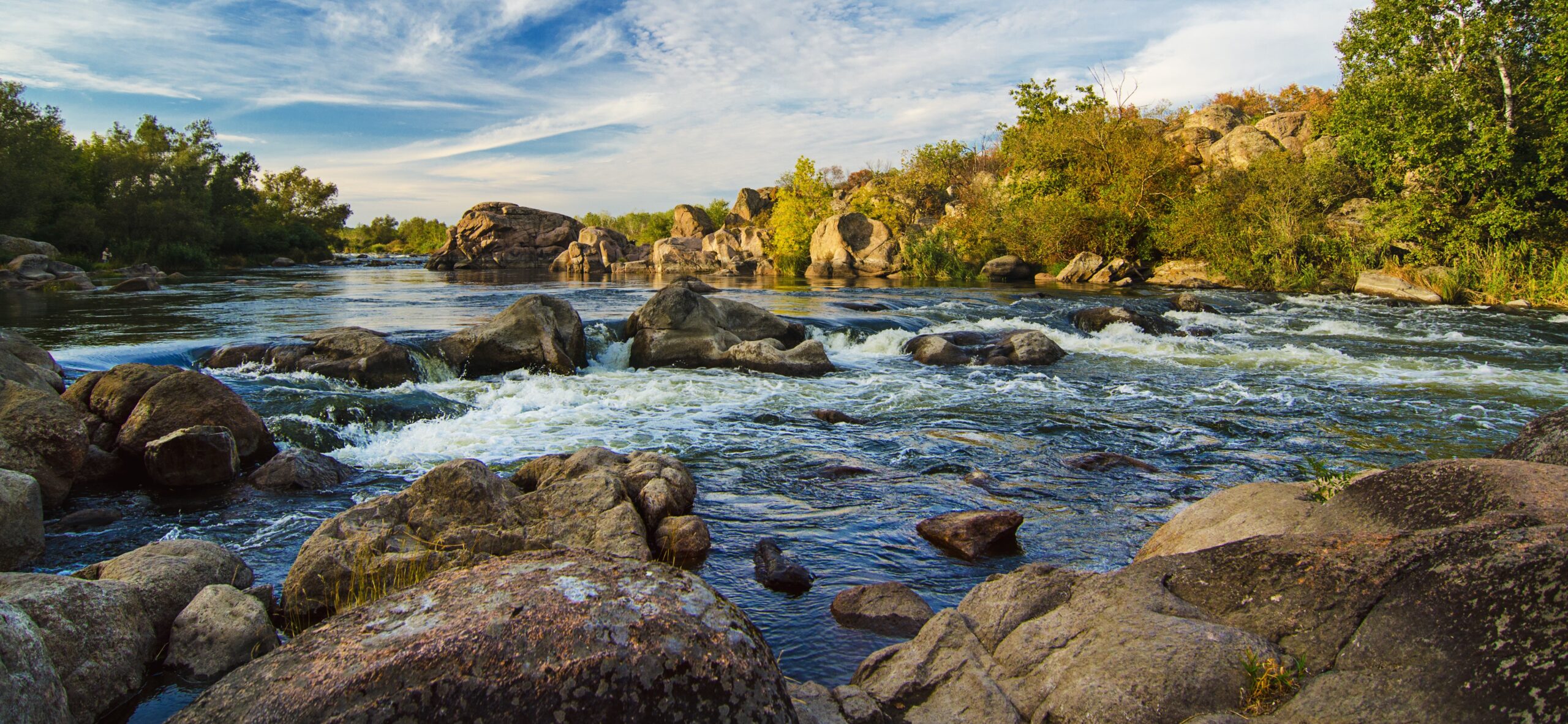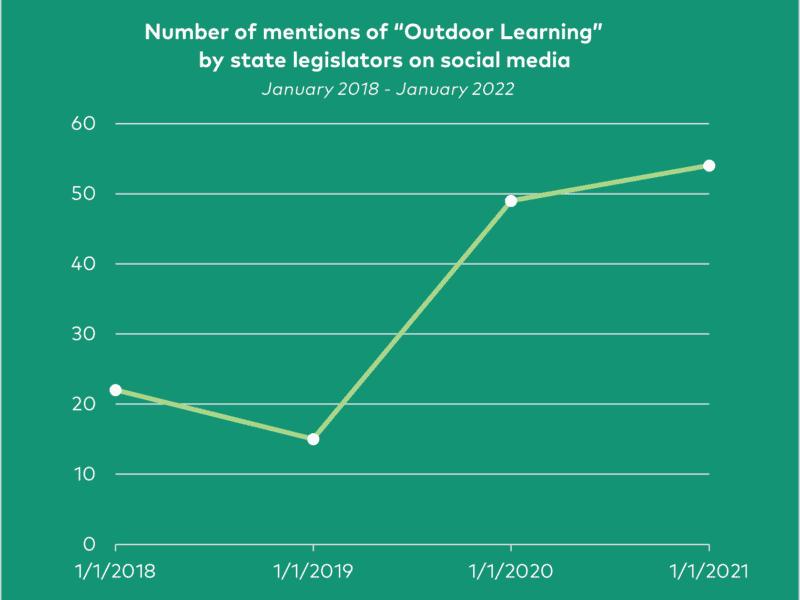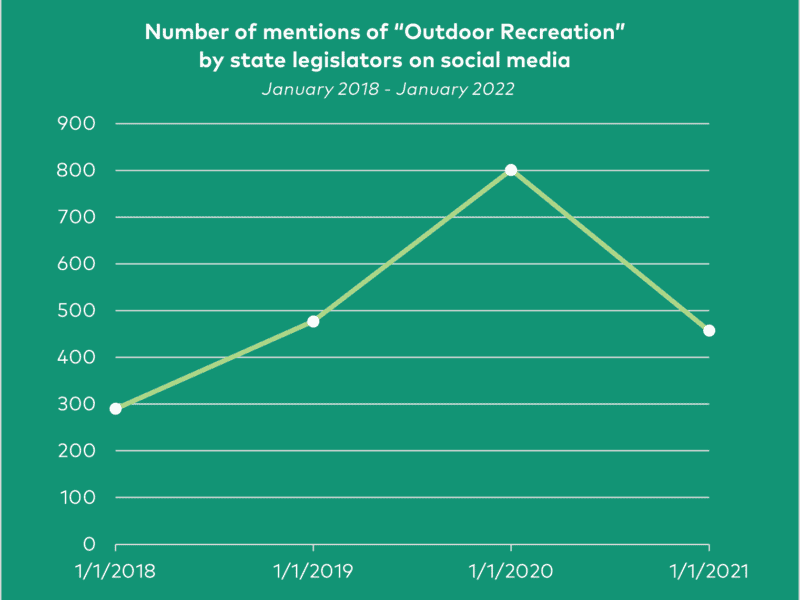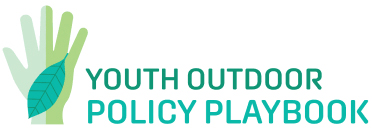
Annual Report
2021 Youth Outdoor Policy Trends Report
Our annual trends report shares innovative ideas in youth outdoor engagement to inspire legislators, advocates, communities, and youth to replicate, rethink, and collaborate to build equitable youth outdoor opportunities.
Overview
2021 was a big year for youth outdoor policies. Momentum around youth outdoor engagement has been growing over the past several years. This trend has accelerated with an increased urgency due to the COVID-19 pandemic, which emphasized the value of time outside and also highlighted the inequities facing many kids and communities. As we begin 2022, we continue to track youth outdoor policies—you can follow along on our 2022 Outdoor Policy Legislation Tracker.
The policies included in this trend report:
- address outdoor access and equity, outdoor learning and education, wellness, and/or funding
- focus on youth or have a significant impact on youth
Jump to a Section: Access and Equity | Learning and Education | Wellness | Funding and Governance | Federal Policy | Exciting Ideas
Methods
For each section, we have included a summary of some of the existing policies and outlined specific policy advancements from 2021. The bills included in this document were identified by the National Caucus of Environmental Legislators, the North American Association for Environmental Education, Children and Nature Networks, and Meridian Institute as possible examples of policy that can support youth outdoor engagement. As a partnership we do not endorse any specific bills or policy ideas, but are sharing these as inspiration for local champions and legislators considering what might work in your state. It is possible we missed some policies. We welcome suggestions for additions or corrections at rpaulekas@merid.org.
Outdoor Access and Equity
There is growing awareness that many outdoor spaces are inaccessible to communities that could benefit the most from time in nature. State policy can help facilitate access for underserved populations and reduce barriers for outdoor engagement. Lawmakers have created competitive grant programs, such as No Child Left Inside or equity funds, to directly support outdoor engagement. Other efforts, such as Every Kid in a Park, waive or reduce fees to park access. In other cases, states are working to make outdoor spaces more inclusive. Examples include an Oregon bill prohibiting bias crimes in outdoor spaces and an Illinois resolution underscoring that every child has a right to outdoor recreation opportunities.
2021 Policy Advancements
- Colorado (HB 21-1318) creates an Outdoor Equity Grant Program intended to increase access to the outdoors for underserved youth and their families.
- California Equity Fund and California State Park Adventure Pass (AB 148 and SB 129) offers fourth graders free admission to 16 California state parks.
- Oregon (SB 289) bars those convicted of bias crimes on state waters or publically owned outdoor recreation land from reentering those spaces for up to five years.
- Illinois (HR 0011) maintains that every child should have the right and opportunity to take part in outdoor recreation.
Other Notable Efforts
- New Mexico established the first Outdoor Equity Fund alongside their Division of Outdoor Recreation in 2019 with SB 462.
- Multiple states have No Child Left Inside grant programs for underserved youth. This began with a program in Washington (SB 5843) and has since been adopted in Minnesota (HB 133 and in omnibus) and Nevada (AB 331) as well.
Outdoor Learning and Education
State governments are working to increase outdoor and environmental learning opportunities in a variety of ways. Washington state developed a pilot program for Outdoor Preschool programs in 2019 and, following a successful trial, provided formal licensure with 2021 legislation. Some states are also attempting to improve environmental education through direct curriculum changes, such as expanding the definitions for science education. In other cases, there are efforts to incorporate hunting and fishing education courses into curriculum which could potentially tie into more outdoor engagement.
2021 Policy Advancements
- Georgia (SR 203) establishes an Outdoor Learning Committee to look at issues and needs associated with outdoor learning. Final recommendations are available here.
- Maine (LD 1474) creates pathways for public and private schools to responsibly conduct overnight camping trips.
- New Hampshire (SB 148) includes provisions to add environmental education skills, environmental science, and outdoor recreation to the state’s education criteria.
- New Mexico (SM 1) convenes a task force to expand the use of outdoor classrooms for the state’s schools.
- Oklahoma (SCR 5) encourages the incorporation of hunter education courses into middle or high school curriculums as approved by the Department of Wildlife Conservation.
- Washington (SB 5151) authorizes the state to license outdoor, nature-based childcare programs that enroll preschool or school-age children, teach a nature-based curriculum, and provide daily nature-based learning experiences for at least half of the day.
Other Notable Efforts
- Oregon established an Outdoor School program for every fifth and sixth grade student through SB 439 in 2015 and Ballot Measure 99 in 2016.
- Maryland passed a Green Schools Act (SB 662) in 2019 that provides grants to support outdoor learning opportunities.
- Minnesota established an Outdoor Based Credit Recovery program that allows students to participate in outdoor programming as part of summer school. Funding was appropriated through SF No. 550.
Outdoor Wellness
The mental and physical health benefits of time in nature are well documented, and state governments are seeking innovative approaches to increase outdoor wellness opportunities. States are currently exploring ways of using state and federal funding to incorporate time outside into health programs, while also investigating existing barriers to nature that can be addressed through future laws, policies, and programs.
2021 Policy Advancements
- New York released an Outdoor Rx Committee Report on barriers that exist to providing Veterans with increased access to nature-based therapy and programming. This was initiated by legislation enacted in 2020.
- Texas continued funding the Outdoor Learning Environment (OLE!) Texas initiative, where the Texas Department of State Health Services is allocating resources to promote healthful, nature-based outdoor spaces at early childcare and education programs as a means to reduce obesity in young children
Outdoor Funding and Governance
A number of states have focused on improving youth and general outdoor engagement through the state budget process. This can include increasing grant appropriations, developing or improving trail systems, and more. There has been increased interest in outdoor investment in response to the COVID-19 pandemic as well as new federal funding opportunities such as the Land and Water Conservation Fund and the federal Infrastructure bill.
2021 Policy Advancements
- Alaska: The state budget includes funding for development of the Fairbanks to Seward Multi-Use Recreation Trail.
- Indiana: $60 million included for trails in the state budget.
- Texas: The Texas Parks and Wildlife Department appropriation includes a study to determine the potential for historic, scenic, and/or recreational trails to be created in Texas and to identify potential partners to promote local and regional preservation efforts related to the trails studied.
- New Mexico: Roughly $900,000 appropriated for the Outdoor Equity Fund grant program.
- Washington:
- A tripling of the investment in the “No Child Left Inside” program, to $4.5 million, to fund grants connecting underserved youth to nature.
- Funding and provisions for the “Parks Rx” program at $200,000, which will enable the Department of Health, parks and recreation providers, public and community health representatives, healthcare insurers, and others to design preventative health and wellness pilot programs that can take advantage of the no-cost and low-cost offered by public parks and through parks facilities.
- $375,000 for the Recreation and Conservation Office to conduct an equity review for all grants programs.
- An additional $4 million in Capital Budget funding for outdoor recreation equity grants, much of which is to be distributed in combination with the above equity review process.
- A record-matching $100 million in funding for the Washington Wildlife and Recreation Program (WWRP).
Three Exciting Ideas
It’s not uncommon for policy ideas to be introduced multiple times before becoming law. The following concepts were considered in the previous legislative session and are likely ones to watch for the future.
Right to Nature
In California, Assembly Bill 30 would have established a policy that “all Californians have safe and affordable access to nature and access to the benefits of nature.” Such a policy would then direct how state agencies execute planning, grant-making, and other key decisions.
Youth Leadership
In New Hampshire, a provision originally included in Senate Bill 148 would have created a “youth environmental education and conservation council.” Several states are considering ways of elevating youth voices, particularly around nature access.
Outdoor Wellness
In Texas, House Bill 2159 would have required a “study on state land use to facilitate health and wellness for veterans.” The bill would require coordination between several state departments, and a similar process was recently completed in New York.
Graphics



Bill Tracking
View current policies that we're tracking related to outdoor equity & justice, environmental education & outdoor learning, outdoor health & wellbeing, and outdoor play.
Bill Tracking
